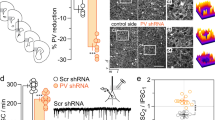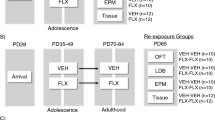Abstract
Tobacco smoking and nicotine exposure during adolescence interfere with prefrontal cortex (PFC) development and lead to cognitive impairments in later life. The molecular and cellular underpinnings of these consequences remain elusive. We found that adolescent nicotine exposure induced lasting attentional disturbances and reduced mGluR2 protein and function on presynaptic terminals of PFC glutamatergic synapses. Restoring mGluR2 activity in vivo by local infusion of a group II mGluR agonist in adult rats that received nicotine as adolescents rescued attentional disturbances.
This is a preview of subscription content, access via your institution
Access options
Subscribe to this journal
Receive 12 print issues and online access
$209.00 per year
only $17.42 per issue
Buy this article
- Purchase on Springer Link
- Instant access to full article PDF
Prices may be subject to local taxes which are calculated during checkout



Similar content being viewed by others
References
Casey, B.J., Tottenham, N., Liston, C. & Durston, S. Trends Cogn. Sci. 9, 104–110 (2005).
Chassin, L., Presson, C.C., Rose, J.S. & Sherman, S.J. Health Psychol. 15, 478–484 (1996).
Slotkin, T.A. Toxicol. Appl. Pharmacol. 198, 132–151 (2004).
Jacobsen, L.K. et al. Biol. Psychiatry 57, 56–66 (2005).
Jacobsen, L.K., Slotkin, T.A., Mencl, W.E., Frost, S.J. & Pugh, K.R. Neuropsychopharmacology 32, 2453–2464 (2007).
Mathers, M., Toumbourou, J.W., Catalano, R.F., Williams, J. & Patton, G.C. Addiction 101, 948–958 (2006).
WHO-Europe. Health policy for children and adolescents. (No. 4) (eds. C. Currie, et al.) (Copenhagen, 2004).
Spear, L.P. Neurosci. Biobehav. Rev. 24, 417–463 (2000).
Counotte, D.S. et al. Neuropsychopharmacology 34, 299–306 (2009).
Pattij, T. & Vanderschuren, L.J. Trends Pharmacol. Sci. 29, 192–199 (2008).
Robbins, T.W. Psychopharmacology (Berl.) 163, 362–380 (2002).
Dalley, J.W., Cardinal, R.N. & Robbins, T.W. Neurosci. Biobehav. Rev. 28, 771–784 (2004).
Mateo, Z. & Porter, J.T. Neuroscience 146, 1062–1072 (2007).
Chudasama, Y. et al. Behav. Brain Res. 146, 105–119 (2003).
Zucker, R.S. Annu. Rev. Neurosci. 12, 13–31 (1989).
Acknowledgements
We thank Y. van Mourik, M. Stegeman, H. Lodder, B. Lodder, C. de Kock and R. Binnekade for excellent technical assistance. Funding was received from Netherlands Organization for Scientific Research (D.S.C., N.A.G., S.S., H.D.M., T.P., A.N.M.S. and A.B.S.), Center for Medical Systems Biology (K.W.L. and R.C.v.d.S.) and VU University (H.D.M.; Starting Independent Research Grant, VU European Research Council).
Author information
Authors and Affiliations
Contributions
D.S.C. and N.A.G. contributed equally to the experiments in this paper. D.S.C., K.W.L., A.B.S. and S.S. designed the molecular experiments. N.A.G. and H.D.M. designed the physiological experiments. D.S.C., A.N.M.S., S.S. and T.P. designed the behavioral experiments. D.S.C. and R.C.v.d.S. executed the molecular experiments. N.A.G. executed physiological experiments. D.S.C. and D.S. executed behavioral experiments. D.S.C., M.L. and S.S. analyzed molecular experiments. N.A.G. and H.D.M. analyzed physiological experiments. D.S.C. and T.P. analyzed behavioral experiments. D.S.C., H.D.M., T.P. and S.S. wrote the manuscript.
Corresponding author
Ethics declarations
Competing interests
The authors declare no competing financial interests.
Supplementary information
Supplementary Text and Figures
Supplementary Figures 1–10, Supplementary Tables 1–4, Supplementary Methods, Supplementary Results and Supplementary Discussion (PDF 2357 kb)
Rights and permissions
About this article
Cite this article
Counotte, D., Goriounova, N., Li, K. et al. Lasting synaptic changes underlie attention deficits caused by nicotine exposure during adolescence. Nat Neurosci 14, 417–419 (2011). https://doi.org/10.1038/nn.2770
Received:
Accepted:
Published:
Issue Date:
DOI: https://doi.org/10.1038/nn.2770
This article is cited by
-
Consequences of adolescent drug use
Translational Psychiatry (2023)
-
Adolescent frontal top-down neurons receive heightened local drive to establish adult attentional behavior in mice
Nature Communications (2020)
-
An automated home-cage-based 5-choice serial reaction time task for rapid assessment of attention and impulsivity in rats
Psychopharmacology (2019)
-
Sublethal exposure to clothianidin during the larval stage causes long-term impairment of hygienic and foraging behaviours of honey bees
Apidologie (2019)
-
Chronic Methylphenidate Alters Tonic and Phasic Glutamate Signaling in the Frontal Cortex of a Freely-Moving Rat Model of ADHD
Neurochemical Research (2019)



